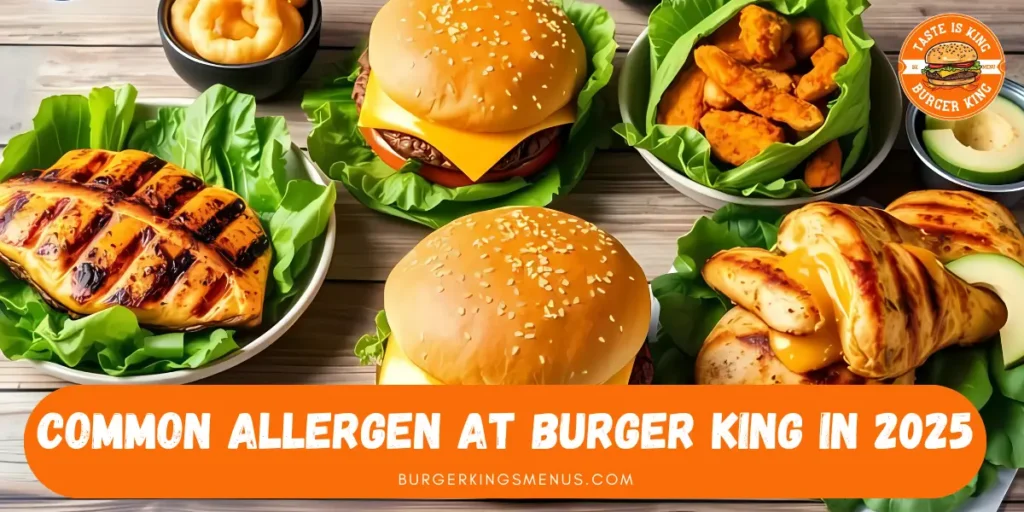The Ultimate Burger King Allergen Menu Guide for Peace of Mind

Burger King Allergen Menu is an excellent guide to help customers who suffer from food sensitivities or allergies. The lists of ingredients used in their menu items. And also highlights the most common allergens, including eggs, gluten, dairy and peanuts. It also lists soy, peanuts, and many others. This menu is an important tool for people who need to avoid certain ingredients for their health or safety while enjoying fast food.
Table of Contents
ToggleThe menu of allergens helps to make more informed decisions by providing details about the foods that contain specific allergens. It is important to remember, however, that even when a product does not contain an allergen. Cross-contamination can happen at the food preparation area. Burger King Allergen Menu takes care, but for those who suffer from severe allergies. It’s always best to ask staff for extra help when ordering.
What is Burger King Allergen Menu?
The menu for allergens at Burger King Menu is a special guide which lists the ingredients used in each dish and highlights the most common allergens. These include ingredients that can cause allergic reactions for people who are sensitive to certain foods like eggs, dairy, gluten, soy, as well as peanuts and others. The allergens menu helps customers identify which foods are safe to eat based on their specific allergies.
Common Allergen at Burger King in 2025
As with many fast-food chains, Burger King Allergen Menu uses a variety of ingredients that could potentially cause allergic reactions. Here are some of the most common allergens that you need to be aware of while looking at the menu of allergens:

Gluten
Gluten is a type of protein that’s found in barley, wheat Oats, and rye. It’s commonly present in rolls, breads, pizza crusts as well as many processed food items. For people with celiac disease and gluten. It can cause an immune response which damages the small intestine. While those with non-celiac gluten sensitivity may feel discomfort such as bloating headaches, stomach cramps, or any digestive issues. It’s commonly in breads, pastas, and fried foods.
The Symptoms of a reaction includes:
- Digestive issues
- Fatigue
- Joint Pain
- Skin Rashes
- Headaches
Dairy
Dairy is made up of milk and is a source of common allergens, such as Casein and Whey. People who are lactose intolerant have difficulty digesting lactose sugar in milk. This could cause bloating, gas, and diarrhea. People who suffer from dairy allergies experience an immune reaction to milk proteins. It’s found in cheese, milk, butter, milkshakes, sauces, and ice cream.
The Symptoms of a reaction includes:
- Stomach cramps
- Swelling
- Skin rashes
- In severe cases, difficulty breathing
Eggs
Eggs are a common allergen, especially for children who are young. Egg allergies occur when the body reacts to proteins in egg whites or yolks. Which can cause symptoms that range from mild hives to more severe reactions like anaphylaxis. A small amount of egg could cause an allergic reaction in people. It’s found in Mayonnaise, burger buns, fried food coatings, and breakfast items like sandwiches or wraps.
The Symptoms of a reaction includes:
- Skin rashes
- Digestive problems
- Difficulty breathing
- In severe cases, anaphylaxis
Soy
Soy is a legume and a common allergen, especially in processed food items. It’s present in tofu. Soy milk as well as other processed food ingredients. It includes soybean oil, soy lecithin, and soy sauce. Soy allergy is most commonly seen in children, but they can persist into adulthood. It’s found in soy milk, tofu, processed sauces, dressings, and many packaged food items.
The Symptoms of a reaction includes:
- Skin reactions like hives
- Digestive problems
- Throat swelling
- Difficulty breathing
Peanuts and Tree Nuts
Peanut allergies are one of the most common and severe food allergies, often causing life-threatening reactions. Tree nuts, such as almonds, walnuts, cashews, and pecans can also cause severe reactions in some individuals. These allergens are commonly present in baked goods, sauces, and oils, and cross-contamination is a common risk. It’s found in nut butter, snacks, baked items, sauces, and oils.
The Symptoms of a reaction includes:
- Anaphylaxis
- Skin hives
- Swelling of the throat
- Difficulty breathing
Wheat
Wheat is another protein found in grains which is frequently confused with gluten. The people who suffer from wheat allergies react to wheat’s proteins and can cause symptoms like asthma, hives, as well as digestive problems. The wheat allergy is different from celiac diseases, which is an immune reaction to gluten. It’s found in bread, pasta, baked goods, and many processed food items.
The Symptoms of a reaction includes:
- Hives
- Stomach cramps
- Difficulty breathing
- Anaphylaxis
Sesame
Sesame as well as oil are becoming more well-known as common allergens. Especially due to the increase in severe reactions to these seeds. Sesame allergies can cause symptoms that range from mild skin reactions up to severe anaphylaxis. It’s important to note that many food companies have recently started to highlight sesame as a major allergen in their ingredients. The Sesame is found in seeds, oils, hummus, and certain breads or baked goods.
The Symptoms of a reaction of allergen includes:
- Skin rashes
- Difficulty breathing
- Digestive problems
- In severe cases, anaphylaxis
Fish and Shellfish
Fish and Shellfish allergies are two of the most common causes of food-related anaphylaxis. Fish allergies usually refer to a reaction to proteins found in finned fish like tuna or salmon. Shellfish allergies result from responses to crustaceans like lobster, shrimp. Mollusks like oysters, clams as well as squid. It’s found in seafood dishes, sauces containing fish stock, and some processed foods.
The Symptoms of a reaction includes:
- Skin reactions
- Digestive issues
- Breathing problems
- Anaphylaxis
FAQs about Burger King Allergen Menu
How do I find allergen information at Burger King?
You can find the allergen menu on Burger King’s official website or by asking for a printed copy at the restaurant.
Does Burger King offer gluten-free options?
Burger King Allergen Menu offers some gluten-free options, like their grilled chicken sandwiches or side salads. But cross-contamination is still a possibility.
Can I customize my order to avoid allergens?
Yes, you can customize your order to avoid certain allergens. Such as asking for no cheese or a gluten-free bun. It’s always best to confirm with staff.
Can I trust the allergen menu completely?
While the allergen menu is helpful, cross-contamination can still occur in the kitchen. Si it’s important to communicate with the staff if you have severe allergies.
Conclusion
In conclusion, we conclude that Burger King Allergen Menu can be a helpful tool for navigating the menu safely, but it’s not 100% reliable. If you suffer from an allergy to gluten, dairy allergy or other food allergy. It’s important to be aware of what you order and the way you prepare it.



